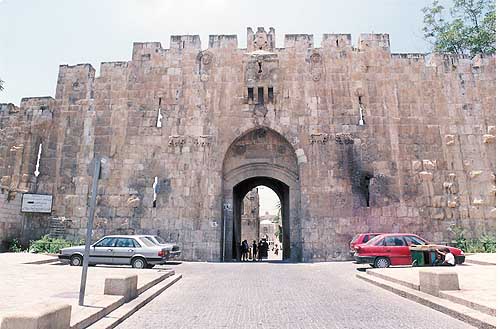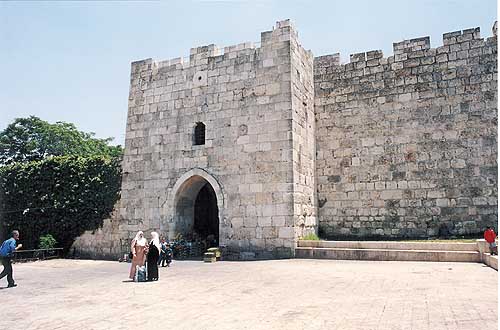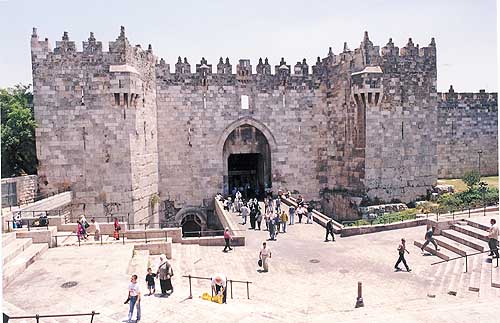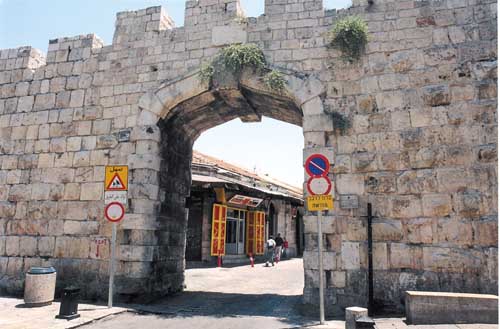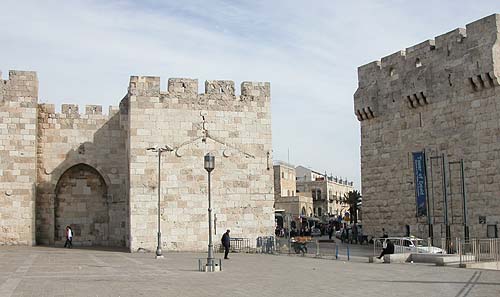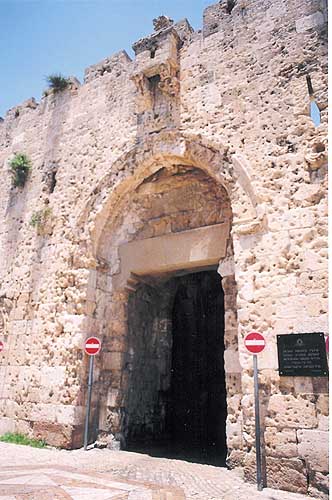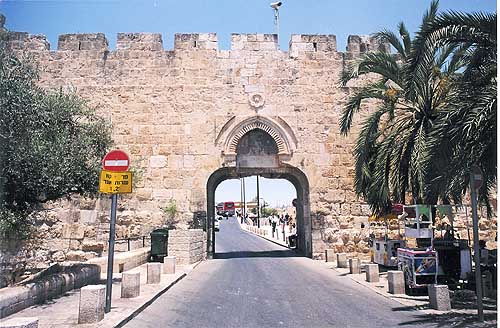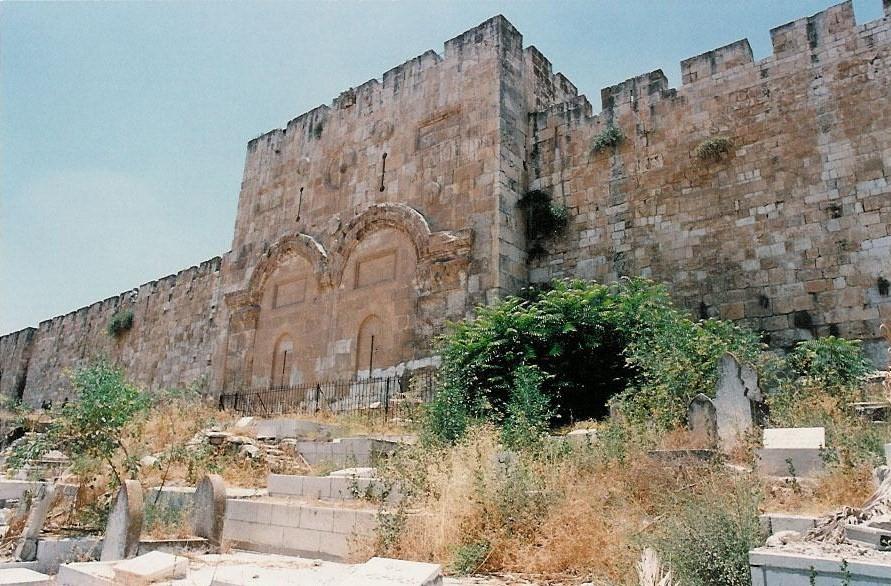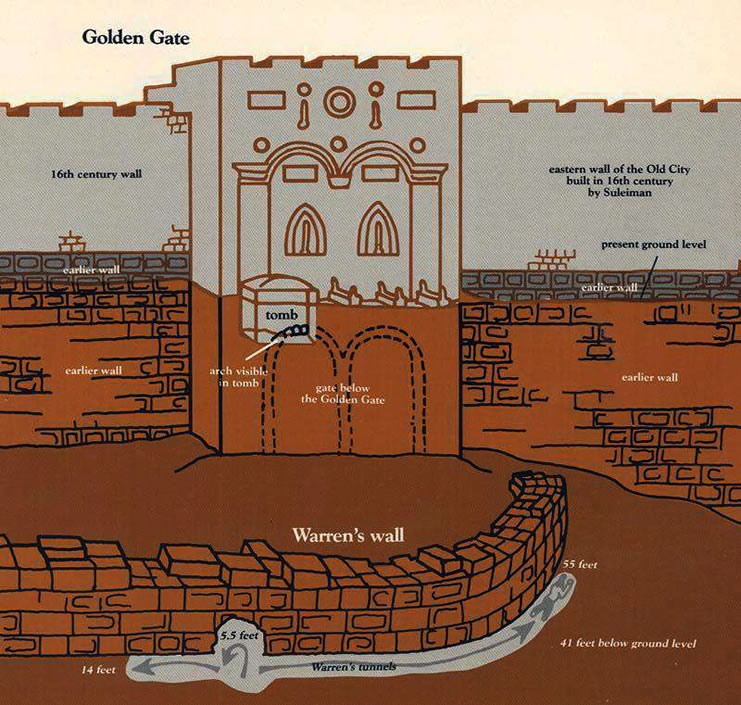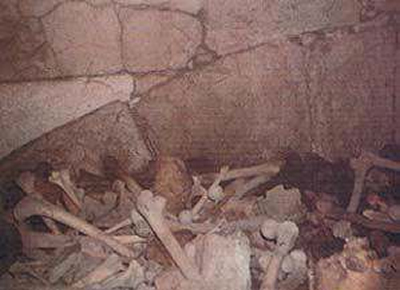Gates of Jerusalem
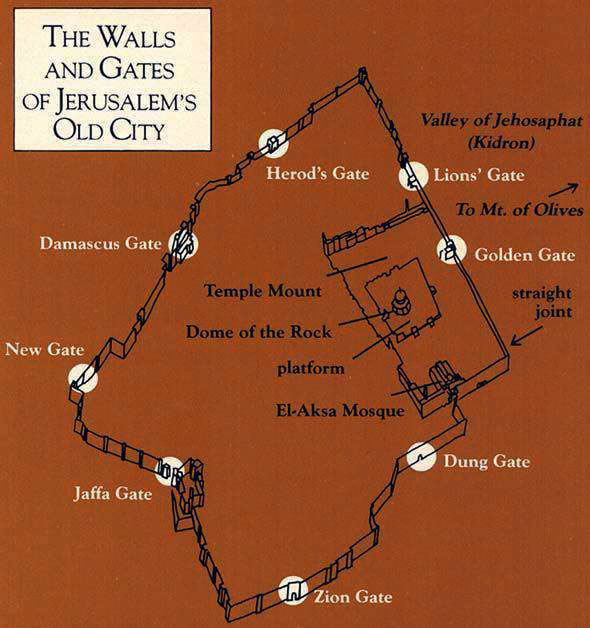
From: James Fleming - Biblical Archeology Review (Accordance Bible Software)
LION’S GATE – The Lions Gate is also known as St. Stephen’s Gate, it is the location that Paul (Saul) witnessed the stoning of Steven. The Lion’s Gate is located in the east wall, and leads to the Via Dolorosa. Near the top of the Lion’s Gate are four figures of lions, two on the left and two on the right. Israeli paratroops from the 55th Paratroop Brigade came through this gate during the Six Day War in 1967.
HEROD’S GATE – Herod’s Gate is in East Jerusalem located on the North Wall of the Old City and leads into the Moslem quarter of the Old City.
DAMASCUS GATE – The road to Damascus once came out of this Gate, you will also notice a smaller Roman Gate to the left, it would have been the Gate the Messiah came through with the Cross. The Damascus Gate is located on the northern wall, it is the busiest and most magnificent of all Jerusalem’s gates. It consists of one large center gate originally intended for use by persons of high station, and two smaller side entrances for commoners.
NEW GATE – The New Gate is located on the Northwest corner of the old city walls. Yes, the New Gate is about 600 years old. It is the newest gate and it was remodeled in 1889.
JAFFA GATE – The Jaffa Gate is located on the Western wall of the Old City. This gate has a lot of history over the past 100 years. The Jaffa gate marked the end of the highway leading from the Jaffa coast and now leads into the Muslim and Armenian quarters. A road allows cars to enter the Old City through a wide gap in the wall between Jaffa Gate and the Citadel. This passage was originally opened in 1898 when Kaiser Wilhelm II of Germany visited Jerusalem. The ruling Ottoman Turks opened it so the German Emperor would not have to dismount his carriage to enter the city.
ZION GATE – The Zion Gate is located in the south part of the Old City. The Zion Gate was used by the Israel Defense Forces in 1967 to enter and capture the Old City. The stones surrounding the gate are still pockmarked by weapons fire. This entrance leads to the Jewish and Armenian quarters. You can see the bullet holes in the gate from the 6 day war in 1967.
DUNG GATE – This Gate leads into the Temple Mount Area and the Western Wall of the Temple Mount. Solomon’s stables were close to this gate. The Dung Gate is located in the south wall. Since the 2nd century, refuse has been hauled out of the city through this gate, hence the name Dung Gate.
GOLDEN GATE – You will notice is closed, The Moslems know the Jewish Messiah will come through this Gate, so they filled it with 16 feet of cement. They also know a Gadol Cohen (High Priest) can’t walk in a graveyard so they bury their dead there. The Golden Gate faces the Mount of Olives on the East wall of the Old City. The Golden Gate was constructed in the post-Byzantine period and the Muslims sealed the gate during the rule of Suleiman.
The area around the Golden Gate, above and below ground. [From Accordance Bible Software—Biblical Archeology Review Archive—January/February 1893 • Volume 9 Number 1]
How to Understand the Golden Gate (Excerpt from "The Undiscovered Gate Beneath Jerusalem's Golden Gate" by James Fleming—BAR, Jan/Feb 1983 Issue)
The Golden Gate is located in a turret protruding from the eastern wall of the Old City of Jerusalem. The two arched portals of the Golden Gate are now mortared closed, but if you could walk through them, you would find yourself on the Temple Mount, which is located in the southeastern corner of the Old City. In short, the southern part of the eastern wall of the Old City is also the eastern wall of the Temple Mount, and if it were open, the Golden Gate would lead into the Old City directly onto the Temple Mount.
On the interior (western side) of the Gate is an elaborate structure that includes domed chambers that may be entered from steps leading down from the Temple Mount.
Outside the Golden Gate is a Moslem cemetery. It covers the slope down to the Kidron Valley (also called the Valley of Jehosaphat).
In the drawing [above], we see, above ground, the Golden Gate and the eastern wall. We also see several structures below ground—in particular, the sealed Lower Gate below the Golden Gate, an underground eastern wall, and a massive curving wall in front (east) of the Lower Gate.The author [James Fleming] of this article stumbled into the large tomb in front of the left portal of the Golden Gate. At the bottom of the tomb, on the face of the wall, he observed wedge-shaped stones, indicating the top of an arch. In the drawing above, the stones that he actually saw are drawn in solid lines inside the tomb. If the partial arch he saw is, in fact, complete, it forms an arched gateway exactly under the left portal of the Golden Gate. Presumably, a similar arched portal is under the right portal of the Golden Gate, thus forming a double-portaled Lower Gate. Except for the stones in the left arch of the Lower Gate that were actually observed, the Lower Gate is drawn with dotted lines to show that it is a reconstruction.
[Below is one of the actual pictures taken by James Fleming inside the tomb in 1969.]
The Lower Gate was built on a stone foundation and was set into an earlier city wall. The present 16th-century A.D. wall was built on top of this earlier wall. Two to three courses of this earlier wall may still be seen above ground level and are shown in the drawing as rectangular stones with rough, projecting faces and three-to six-inch margins around their edges. These stones are much larger than and different from the masonry in the wall built on top of them...Forty-one feet below ground level and 46 feet in front of the eastern wall of the Old City is a wall discovered in 1867 by Captain Charles Warren. Warren encountered the wall after he sank a shaft 143 feet east of the Golden Gate and then burrowed westward underground along bedrock toward the Temple Mount. This underground wall obstructed his progress, so he tried to chisel through it in order to reach the Old City wall. After penetrating 5.5 feet into the underground wall and failing to come out on the other side, he decided to tunnel south to try to get around the wall. After tunneling 14 feet south without coming to the end, Warren turned around and dug north for 55 feet until an earthfall in the tunnel stopped him. Shortly before he was forced to stop tunneling, Warren observed that this underground wall obstructing his progress had started to curve west toward the Golden Gate and the Old City wall.
Warren further observed that the masonry in this curving underground wall resembles the masonry of the earlier Old City wall exposed above ground in courses numbered 1 and 2 on either side of the Golden Gate. It also resembles the masonry in the seven lower courses immediately north of the Straight Joint.
The author uses these comparisons of masonry to try to date the earlier wall and the Lower Gate that was built into it.
Copyright Notice for the Gate Photos and Descriptions: © 2013 TheGoldenReport. Jerry Golden | PO Box 10268 | Jerusalem 91102 Israel. Source: The Golden Report
Back to the Templemount.org Homepage
Webpage created 6/16/2013 - brh
